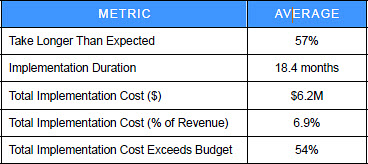ERP failure: New research and statistics

Panorama Consulting today released results of a study, called 2010 ERP Report, comparing gaps between customer expectations and actual results achieved on enterprise resource planning (ERP) projects.
While the findings are consistent with similar studies, Panorama is a consulting company and not a neutral research organization, although it is not affiliated with software vendors. This does not invalidate the results, but as a policy matter we should retain some skepticism toward the findings.
Key Findings
The research describes five primary results:
- ERP implementations take longer than expected
- ERP implementations cost more than expected
- Most ERP implementations under-deliver business value
- Software as a service (SaaS) implementations take less time than on-premise ERP implementations, but deliver less business value
- Companies do not effectively manage the organizational changes of ERP
Implementation length. The study states that more than half the implementations surveyed exceed planned time:
According to Panorama’s study, 57% of ERP implementations take longer than expected (see table below). This challenge is partly attributed to the fact that many companies in our study either had unrealistic expectations regarding timeframes and/or did not account for key project activities in their implementation planning processes.
As the table indicates, both time and budget frequently exceed planned levels:

Implementation budget. The report compares implementation budget variance in 2010 to a comparable study performed in 2008:
As illustrated in the table above, 54% of ERP implementations go over budget. This is a slight decrease from the 2008 study, which showed that 59% of implementations cost more than planned. The finding is attributed to the fact that many organizations in our study failed to identify and budget implementation costs not attributable to software vendors, such as project management, organizational change management, hardware upgrades and the like.
Measurable benefits. These figures are perhaps the most damning in the study. The report says a significant number of implementations surveyed did not deliver anywhere near the anticipated benefit or value:
As Figure D (below) outlines, 41% of companies surveyed fail to realize at least half of the business benefits they expected from their ERP systems, and 22% of implementations fail to deliver at least some measurable business benefits from their ERP solutions. In addition, over one in three companies surveyed (40%) realized major operational disruptions after implementation go-live, such as the inability to ship products or to close the books. Finally, only 68% of executives and 61% of employees are at least somewhat satisfied with their ERP solutions.
SaaS implementations. The study concludes that SaaS deployments are faster than traditional, on-premise implementations yet are even less likely to deliver expected results. This stunning claim demands additional research and detail:
The study reveals that on average, SaaS and hosted solutions are implemented in less time (11.6 months for SaaS vs. 18.4 for on-premise), at a lower cost (6.2% vs. 6.9% of annual revenue, Figure F) and at a slightly higher level of executive satisfaction (52.6% vs. 50.0%) than traditional on-premise solutions. However, as with any ERP solution, SaaS has its drawbacks. SaaS implementations are significantly less likely to deliver the expected business benefits (23.5% vs. 42.9%) than on-premise solutions. In addition, SaaS implementations are significantly more likely to exceed budget than on-premise initiatives (70.6% vs. 59% for other delivery options).
Implementation change management. The study finds that most organizations have a hard time managing the business transformation aspects of ERP. Since transformation is often an important reason companies take on ERP projects, these conclusions are not surprising:
Over 53% of implementing organizations assess their ability to deal with change as fairly poor or very poor. In addition, 47% say communication between management and employees is poor. These types of environments are not conducive to effective ERP implementations. Organizational change management tools, however, help address such barriers to make the rollouts more successful.
In addition, over 60% of organizations suffer from poor visibility of data and poor integration in their old systems. This metric suggests that employees using a new ERP system have strong organizational resistance and steep learning curves
THE PROJECT FAILURES ANALYSIS
The findings reported here are consistent with research performed by others on this subject. For this reason, I accept the findings as appearing to be generally valid.
At the same time, Panorama is consulting organization and these results are therefore self-serving, which makes the data suspect even if it is accurate. Panorama's research is worthwhile, but would be more credible if the company engaged an independent research organization to conduct similar studies in the future.
In addition to adding credibility, a professional research firm would ensure consistency of the study methodology year over year. This would increase the value of the research by adding confidence to both the conclusions and the trend information over time.
On a different subject, the report presents a startling and unexpected discussion about the business value achieved from SaaS versus on-premise implementations. I would like additional research and details exploring this assertion, which is presented as fact in the report:
While SaaS is clearly on a high-growth trajectory, our independent findings reveal that industry hype is misaligned with actual results.
My take. I applaud Panorama for conducting this research and encourage the company to take whatever steps are required to ensure the research is independent, reliable, and consistent over time.